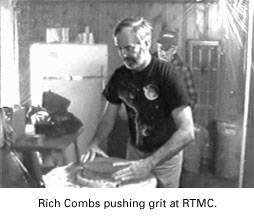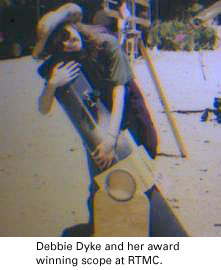|
Types of Telescopes
"What kind of scope should I buy?" TVS Loaner Scopes Make Your Own Scope Types of TelescopesThere are many types of telescopes out there. Here's a quick run down of the major types you'll see for sale at your local telescope store.Refractors Refractors are what most people visualize when you say the word "telescope". They use glass lenses. Reflectors Reflectors come in several configurations. They use mirrors. Schmidt-Cassegrain (SCT) SCTs are reflectors that use both a mirror and a lens (of sorts). Maksutov (Mak) Maks look similar to SCTs. Return to Top "What kind of scope should I buy?"Amateur astronomers hear that question, or one very similar to it, a lot. However, asking that question is like asking someone "What kind of car should I buy?". The answer to both would be "It depends".You have to go through a list of questions to see which type of scope is best suited for your needs. Where will you be observing - at your home, or at a dark sky location? How much money are you willing to spend? Will you want to do any astrophotography? Before you buy, here are some suggestions:
Here are some other references:
TVS Loaner ScopesSo are you thinking about buying a telescope but wondering what it will be like? How easy is it to use: carry, set up, point, find things? What can you see? Maybe you would like to get a little hands on experience before you spend hundreds or thousands of dollars on a mysterious high tech instrument? Maybe you would like to try out a few different types of telescope before deciding which type is best for you? Read "What Kind of Scope Should I Buy" above. One of the things you can do, if you are a member of the club, is to rent one of our loaner scopes. For more information about the program, visit our Loaner Scope web page.Return to Top Make Your Own ScopeIf you'd like a little bit of a challenge, you can make your own scope. There are several scope making books out there to help you make one of your own. However, it is easier if you can be involved in a telescope making workshop or class.One place that you can go is the Telescope Makers' Workshop run through the Eastbay Astronomical Society (EAS). They meet every Friday night at the Chabot Space & Science Center in Oakland. For more information on their program, visit the EAS web site. In the past, TVS has conducted telescope making workshops for its members. Here's a little blurb our TM (telescope making) leader wrote that will give you an idea of what's involved: The Tri-Valley Stargazers Telescope Making Workshop by Rich Combs 1996 (thanks Rich!) The Tri-Valley Stargazers Amateur Telescope Makers Workshop was started in 1991. That year a dozen enthusiastic members of the club met twice a week and spent as long as five months to grind, polish, figure their own mirrors, and assembled them into home made dobsonian mounts. This first group of ATM's used cement tools with ceramic tiles epoxied on their surface. In the five years since, the techniques have been streamlined a bit, so that this year it takes four months, meeting only one night a week, to complete the mirrors, and a few Saturdays to make the mounts. Over 45 scopes have been made, the largest being 12.5", and most being 6" f/8, which has become the standard beginners scope. A new group meets once a year, usually in the fall, although in 1996 we started in March. There are eight "Grit Pushers" in the current group, and we hope to have the mirrors and mounts completed by the end of June. Some details of the standard 6" f/8 scopes are as follows. We use pyrex mirror blanks and plate glass tools from Newport Glass in Southern California that are pre-molded, or generated, to an f/8 curve. This allows us to start with #120 abrasive, which is adequate to remove the mold marks. After working through the normal sequence of silicon carbide abrasives, #120, #220, #320, #500, then 12micron and 5 micron aluminum oxide, we make a pitch lap with Gugolz pitch. The pitch is poured onto a warmed tool, and after 3-5 minutes, the paper dam is stripped off, and a wood paint stirrer that has been soaking in water is used to channel the tool, and a warm mirror used to shape the pitch to the mirror curve. Polishing takes from 4 to 8 hours using Cerium Oxide. We finish with a half hour of red rouge, which gives an excellent surface finish, and provides gentle polishing action for the figuring of the parabola. The mounts are standard Dobsonian design, with most of the gotcha's worked out over the years. The completed scopes end up costing about $350, but this includes two eyepieces, a Telrad Finder, rack and pinion focuser, four vane spider, and enhanced coating secondary mirror. We make the mirror cells, and the rest of the mount. The mirrors are coated at QSP in Santa Ana, CA, with whatever coating the "grit pusher" prefers. And then......first light! I must extend my congratulations to each ATM who has demonstrated the perseverance to complete their telescope. We have had folks with all kinds of backgrounds, including mechanics, liquor store operators, astrophysicists, students, store clerks....and all ages, from a sixth grader to senior citizens. I would also like to thank Jim Nunes and his family, who have provided the facility at their home in Sunol, which has made the workshop possible. Also the support of Orion telescopes in providing a discount on their ATM supplies, QSP for their rapid, high quality coating services, and the Tri-Valley Stargazers Astronomy Club for their encouragement with this project. 
TVS telescopes win awards at RTMC(Riverside Telescope Makers' Workshop)The telescope built by Shannon Cullen in the first year later became the first telescope built by an active TVS member to win an award at the Riverside Telescope Makers Conference (Honorable Mention for a Good Telescope Built by a Junior Astronomer). Shannon was 15 years old when the telescope was built. (TVS member Carter Roberts has won several awards at Riverside before becoming a TVS member.) In 1997, Debbie Dyke received a certificate at RTMC for a telescope constructed in the TVS workshop (Honorable Mention for a Well Built First Telescope). Debbie is only the second person to win an award at RTMC while being an active TVS member.  Return to Top |
|||